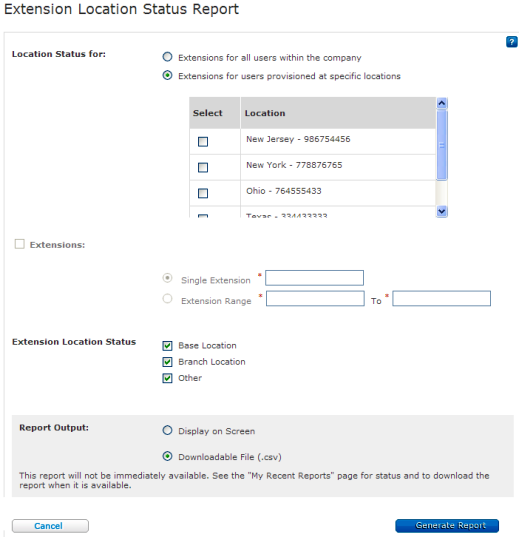AT&T Voice DNA® Administrator Support
Extension Location Status Report
The Extension Location Status Report provides the location status for each extension that you administer. This status supports the E911 move-detection feature, which ensures proper routing of 911 calls when a device is moved. You can use this report to group extensions by status or to determine the status of the individual extensions you administer.
The following values represent a user’s current E911 extension location status:
- Base—User’s devices are checked in at the provisioned location, or user has no devices or no devices checked in.
- Branch—User’s checked-in devices are all at the same customer AT&T Voice DNA® location, but this location is not the user’s provisioned location.
- Other—User’s devices don’t qualify as Base or Branch because they're at an unknown location, or the location status is ambiguous (for example, one phone is at the base location and another is at a branch location).
Note: It is the responsibility of the customer to ensure the E911 Registered Location of each telephone number associated with the AT&T Voice DNA service is always accurate. (See Move IP Phones for more information.)
In addition to the location status (Base, Branch, or Other), the Extension Location Status Report provides the following details for each user:
- Extension
- Phone number
- Name (last, first)
- Provisioned location (location name and location ID)
- Branch name
- Branch location ID
- Last device check in
To run an Extension Location Status Report
- Open the AT&T Voice DNA Administrator Dashboard. (For help with logging in, see Log In.)
- At the top of the page, click REPORTS.
- On the All Reports page that appears, under Service Usage, click Extension Location Status Report. The Extension Location Status Report page appears.
If your company is very large, you may see a My Recent Reports tab and an All Reports tab on the Reports page. To run a new report, click All Reports, and then click the report name. To view your pending and saved reports, click My Recent Reports. (For more information, see Manage Reports.)

- Specify the location and extensions you want included in the report:
- To include all locations and all extensions, select Extensions for all users within the company.
- To include specific locations, select Extensions for users provisioned at specific locations, and then select the locations you want to include.
- To include specific extensions, select Extensions for users provisioned at specific locations, specify the locations you want, and then check Extensions. Select Single Extension or Extension Range, and then enter the appropriate extensions.
- Select the Extension Location Status that you want to include in the report: Base Location, Branch Location, or Other. You can select more than one.
- Under Report Output, select Display on screen or Downloadable file (.csv).
Note: If you select Display on screen, you’ll get another chance to download the file later. - Click Generate Report:
- If you selected Display on screen, you can view the report results now. To save the file, click Save results to a text file.
- If you selected Downloadable file (.csv), a report confirmation window opens. Click Download Report (CSV). In the File Download window that appears, click Open to view the results now or Save to save the results as a text file on your computer.
Note: For larger companies or data sets, the report may not run immediately. Instead, a confirmation message appears, telling you to check the My Recent Reports tab for the report. (For more information on using the My Recent Reports tab and managing reports for large companies, see Manage Reports.)
